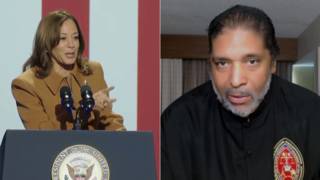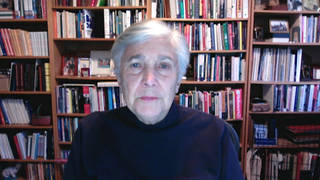
Related
Topics
Guests
- Steve BarrCEO and founder of Future Is Now, a nonprofit that works to improve public education by empowering teachers to take action in their schools, districts and unions. He also founded Green Dot Public Schools, a charter school network.
- Brian Jonestaught elementary school in New York City for nine years and is now pursuing a doctorate in urban education at the CUNY Graduate Center. He is a member of the Movement of Rank and File Educators, the social justice caucus of the United Federation of Teachers, and co-narrator of the film, The Inconvenient Truth Behind Waiting for Superman.
The battle over charter schools is heating up after New York City Mayor Bill de Blasio blocked three privately run charter schools from using rent-free space inside public schools. The city also announced it will cut $210 million in charter school construction funding and use the money toward universal pre-K and after-school programs. The moves have set off a fierce debate in New York and the country and have even pitted de Blasio against New York Governor Andrew Cuomo, a fellow Democrat. We are joined by former public school teacher Brian Jones and Steve Barr, founder of the Green Dot Public Schools, a charter school network.
Transcript
JUAN GONZÁLEZ: A battle is heating up in New York City and state over the future of charter schools. New York City Mayor Bill de Blasio recently blocked three privately run charter schools from expanding and using rent-free space inside public schools. The city also announced it will cut $210 million that the Bloomberg administration had set aside for charter school construction and use that money toward universal pre-K and after-school programs.
AMY GOODMAN: The moves have set off a fierce debate in New York and the country and have even pitted de Blasio against New York Governor Andrew Cuomo, a fellow Democrat. A pro-charter group called Families for Excellent Schools recently launched this television ad campaign.
UNIDENTIFIED FATHER: I voted for Mayor de Blasio because he talked about looking out for the have-nots.
UNIDENTIFIED MOTHER 1: Mayor Bill de Blasio talks about the Tale of Two Cities, but yet he wants to take away options from the communities that need it the most.
UNIDENTIFIED MOTHER 2: My daughter would have a better opportunity at a charter school.
UNIDENTIFIED FATHER: Charter school is doing so great for my son. I don’t know why he wouldn’t be supportive of that.
NARRATOR: Despite the success of public charter schools, Mayor de Blasio wants to stop them from opening and expanding, taking great schools away from New York City kids.
UNIDENTIFIED MOTHER 3: My kids deserve a good choice and the chance to succeed.
JUAN GONZÁLEZ: In response to the ad, Mayor de Blasio defended his stance on charter schools. He spoke on CBS New York.
MAYOR BILL DE BLASIO: Certain charter operators were favored. We won’t do that. And if that’s what is generating this advertising campaign, that a privileged few will continue to be favored, they can advertise all they want. It’s not going to affect my view of the world.
AMY GOODMAN: To talk more about the debate on charter schools in New York and around the country, we’re joined by two guests. Steve Barr is the CEO and founder of Future Is Now. He also founded Green Dot Public Schools, a charter school network. He’s joining us from Los Angeles.
Here in New York, Brian Jones is with us. He taught elementary school in New York City for nine years, is now pursuing a doctorate in urban education at the CUNY Graduate Center. He’s a member of the Movement of Rank and File Educators, the social justice caucus of the United Federation of Teachers.
We welcome you both to Democracy Now! But before we go to both of you, Juan, you’ve been writing extensively about the charter school movement. It’s one of the first big controversies that de Blasio, as the mayor of New York, is facing, and, very interestingly, one of his major opponents is his fellow Democrat, the governor of New York, Governor Cuomo.
JUAN GONZÁLEZ: Yes, well, this has now been set up now, increasingly, as a battle between the governor and the mayor, with the—many of the charter school supporters counting on Governor Cuomo to be able to hold back the changes that Mayor de Blasio is seeking to make. And to be clear, Mayor de Blasio has not said he’s not going to expand further charter schools. In fact, he has—his administration approved several new charter schools. But his main concern appears to be over, one, the increasing problem of co-locations of schools, not just charters, but public schools, as well, that many, many public schools in the city are now facing the fact that there are three, four and five schools in the same building, huge battles breaking out over who gets to use the auditorium, because there’s only one auditorium, who gets to use the cafeteria, who gets to use the gym, and it’s creating huge problems of overcrowding, because the previous administration attempted to force too many schools and not really deal with the needs of the individual schools. So that’s been a major issue.
AMY GOODMAN: So you also have like elementary school kids in with high school kids?
JUAN GONZÁLEZ: With high school kids or middle school kids, and especially special education, which often needs more room, smaller classes, more special services. And so, the mayor is saying, “Hey, we’ve got to get a grip on what is happening to the regular public schools in the process of creating these charter schools.” So that’s a big issue.
And then, of course, the other issue is rent. Do charter schools, which are private organizations, largely using public money—should they be paying rent in—when they use public schools? In most cities across the country, the charter schools create their own buildings and finance their own buildings, but in a few cities, like New York, the policy has been to give them rent-free space. And the mayor has made clear that he’s opposed to that idea. And, in fact, actually, state law seems to back him up, because the state law says that when charter schools use public schools, the city shall charge cost, but this has not yet been fought out in a court battle, so that’s why there’s a continuing issue that the previous administration did allow rent-free schools. So these are some of the issues that are being fought out now.
AMY GOODMAN: We just played a very slick, polished ad for charter schools. Brian Jones, who is behind the push for the expansion of charter schools?
BRIAN JONES: Well, certainly, there are—I think we should say from the outset that not all charter schools can be painted with the same brush. Some of them are progressive. Some of them are what you might call mom-and-pop charter schools who are quietly going about their business of teaching and learning. But I think who’s really behind the push are the expansionist charter schools, the ones who are trying to grow into these kind of charter school empires. Eva Moskowitz wants to have a hundred charter schools. And so, she has an interest—
AMY GOODMAN: And she is?
BRIAN JONES: Eva Moskowitz, the former city councilmember who runs the 22 Success Academies in New York City. So she has an interest in the narrative of failure in the public schools. She has an interest in being able to occupy public school space. She has an interest in expansion and in advertising. And she spends north of a million dollars a year, I understand, on advertising. That’s like $1,300 per student.
JUAN GONZÁLEZ: Well, Steve Barr, you’re the founder of Green Dot Public Schools, and certainly Los Angeles is another huge incubator of charter schools. Eli Broad, the big foundation leader there, has been enthusiastically backing them. Could you talk about how you’re seeing the debate in New York City from your vantage point in Los Angeles?
STEVE BARR: Well, I’ve got to clarify one thing: I founded Green Dot Public Schools, not Green Dot Charter Schools. And I don’t—I care less about charter schools except for how they affect public schools. I think there’s an ability to create some good research and development of what school districts could become. I think our schools—I listened to a lot of teachers. They felt left out of the decision-making process. They felt like dollars were not making it into the classroom. And we used all those reforms to be very successful in areas where there was 50 to 60 to 70 percent dropout rates; we retain and graduate 80 to 90 percent of the same kids, and the vast majority of them go on to university. So, I’m a public school advocate, and charters are just a tool—a progressive tool.
And the other thing I would say about that somehow these are private entities, it’s no more of a private entity than Pacifica or KPCC, which I give to. They are nonprofits. The idea that somehow—that this narrative that I got into this with my life savings or a lot of people that do this work are in it to somehow make some money is ludicrous. We’re in it, I think, really, to change the public school system. It was stagnant for a long time. There was a take-it-or-leave-it mentality. I’m a member of the left. I’m a liberal Democrat. I think we’ve been on the defensive for so long that, you know, we just got used to defending and not innovating. And I think there’s a lot of us that are Democrats that took the mantle of this tool and said, “Look, we can prove a different way of educating kids. We can push decisions close to the stakeholders. We can empower people that have been left out of the political system. We can create ownership.” And that’s what you’re seeing here. It’s not an evildoer thing.
AMY GOODMAN: Brian Jones?
BRIAN JONES: Well, I just want to respond to that for a minute. We have more than a dozen charter school CEOs in New York City who make more than the chancellor, and the chancellor oversees over 1,600 schools. Some of these charter school CEOs have just two schools and make nearly half-a-million dollars. So the idea that some people aren’t in this for the possibilities for personal gain, I think, is just absolutely not true.
The other thing is that it’s important to understand the private nature of charter schools. What Eva Moskowitz did, where she closed down her 22 schools for a day and provided meals and T-shirts for people and free transportation to Albany to protest, well, that’s how she got 7,000 people to protest. If a public school shut itself down to attend a political rally, we would be—we would have a serious problem on our hands. But a private organization can do that.
The other—the last thing is just that, you know, I’m not an expert in Mr. Barr’s schools, but there’s plenty of reporting out there that even the schools that he has attempted to run in Los Angeles and New Orleans have run into trouble. And I feel, again and again, there’s a pattern that charter school leaders hold out great promise, make huge claims and promises, and then run into the usual problems that people run into when they’re trying to serve some of our neediest students. Solving the problems of public education are not simple and straightforward. There’s no magic bullet. There’s no management technique or administrative shuffle that’s going to solve those problems. And I feel that charter schools have fallen way below their hype. Their hype is disproportionate to their actual merits.
AMY GOODMAN: Steve Barr, you are founder of Green Dot Public Schools—that’s what it’s called—but it is a charter school network. Could you respond to Brian Jones?
STEVE BARR: Well, I need to educate Brian on some things. First of all, my schools are wall-to-wall unionized schools. And, in fact, I founded a school in the South Bronx called University Prep with Randi Weingarten and the UFT. That school, after its fifth year, is the fourth-best high school in the city in New York. I pay the teachers 22 percent more than their fellow teachers. Rent would affect that. There’s a lot of ownership. People feel—whether the people we’re serving or the people that work at that school. We push decision making to that school site and empower teachers. I don’t—so, the R&D that we would be putting out to—especially as New York City enters into negotiations, is: Why does that school—why do those teachers make so much more on the public dollars than the other schools? And why aren’t we replicating that? That’s the point—I think that’s probably—you know, I’m probably closer to the Al Shanker wing of the charter school movement—that proves that these things work. And I think Brian and I probably would agree on most things about how public schools should be run. I can’t get into tit-for-tat of his talking points, but I’m very proud of the fact that I run a progressive movement here, a progressive school group within a movement. We don’t all agree on everything, but I think we have a lot to share with other public schools, as well.
JUAN GONZÁLEZ: Well, I’d like to ask you about one of the things that you’ve raised in some of your writings, that you don’t necessarily believe that the movement toward, quote, “market share” among some charter school operators is the best approach. Clearly, there are some chains that are bent on growth, whether it’s the KIPP Academy or Uncommon Schools, the for-profit Victory Schools, that are really into creating a market share that will create a critical mass for charter schools. How do you see that strategy versus what you’re trying to do?
STEVE BARR: I mean, I’d like to create—I mean, we’re all in—I’m in the demand business. And, you know, I’m an organizer. And so—and I’d like to organize myself out of a job. My kids go to L.A. Unified schools here in Los Angeles. I think that public school that they go to is better than any charter school. I’d like to scale that school up just as fast as any charter school. Any school that works, we should be looking at and not trying to devise talking points to knock them back. But how do you replicate it?
And, you know, this expansion has nothing to do with, you know, some kind of scheme behind the—you know, behind the curtain. It has to do with people desperate for good schools, period. I think most of the people we serve, they don’t care if it’s a charter school or a good public school. The parents are going to find a good school. They’re desperate for good schools. And that’s what we should be focused on, not the—I truly believe that most of us agree on about 80, 90 percent of this stuff. The problem is, we can’t get past the 10 or 20 percent—and it goes on and on and on—to fix the problem. I’m a parent, and I have to model good behavior to my kids. And part of doing that is I’ve got to sit down with people I normally don’t agree with all the time, and I’ve got to find common ground. It’s so much easier to just sit there and throw bombs at each other instead of finding common ground here.
AMY GOODMAN: Brian Jones?
BRIAN JONES: OK, Steve, thank you for what you’re saying about public schools. I agree that if we can find models—and we can find models of very successful public schools—we need to replicate those things. I think what we don’t need is a persistent narrative of failure, on the one hand, for public schools and a persistent narrative of success or solutions, or we’ve got the cure for cancer, for charter schools. And that’s what we’ve had. That’s what we’ve been dealing with. And that’s what’s unhealthy, where the charter schools are the kind of favored child and the public schools feel like the stepchild.
I do want to say, though, that I think the thing that you were involved in, Steven—not to throw a bomb at you—the Parent Revolution in Los Angeles, is problematic and is not progressive, and was part of that pushing parents towards charter schools as a solution. And I think that’s part of the problem here, is just creating more choices doesn’t necessarily improve education. It reshuffles students, especially for creating choices that are in some ways selective choices and may not serve the same population. Rather, I’d like to see a narrative of, if we have a failing school or if we have a struggling school, how can we improve that school, not how can we just proliferate more choices. Just creating more choices or more options does not necessarily help the neediest students.
AMY GOODMAN: Steve Barr?
STEVE BARR: Well, I mean, you know, Brian, you were on the front lines. You taught for years, and you’ll probably go back and hopefully teach again. It is very hard to be that close to parents who are not being represented, and, you know, being in a school where they go a whole year without a math teacher, or where gangs dominate a school site, like I saw at Locke High School. And they’re desperate. And when I look at that, you know, just like you probably did when you were in the classroom, you’ll do anything for those kids. And that literally is what affects and drives—I don’t know, I can’t speak for all charter school people, I can’t speak for all teachers, but I have to imagine that’s what drives people into their activism.
BRIAN JONES: Well, you know what?
STEVE BARR: Go ahead.
BRIAN JONES: I wish that when I had joined thousands and thousands of public school parents to stop our schools from being closed, I wished that the charter school leaders, with all of their wealth and all their resources, had helped us out. When parents were clamoring to save their schools, were speaking in favor of saving the teachers and the special programs that they felt were serving their children, it seemed like all of those cries and protests fell on deaf ears.
AMY GOODMAN: Steve Barr—
STEVE BARR: There are two—there are two points that you’ve made that I—that really resonate. One, you know, for the last 30 or 40 years, people have fled this system. You know, in Los Angeles—I’ll just be blunt—white people and black people have fled the system. That’s why we have an 83 percent Latino school district. That’s one of the biggest problems. And what was left is people to pick up the pieces and defend this system. We had a big tax revolt. We underfund our schools. We’re all on the same page on that.
How do you turn that around, is what we should be talking about. How do we create wealth and—not wealth, but how do we create opportunities for people so that we want to reinvest in it. I mean, that’s literally—I mean, I jumped a class because we used to have the best public schools in the world in California. And in my adult lifetime, they went from the best to the worst. And what passed as debate is the left, which I’m a member of, saying, “Let’s just give more money to a failed centralized system built for a manufacturing society,” and the right saying, “Scrap it, privatize it,” or indifference. I was trying to figure out a new way of looking at this thing. And that’s what we should be taking about. We should be taking the mantle, moving forward.
And there is an—and I do agree with you, Brian, there is a bit of arrogance about “We have found the new thing.” The only thing I found is—you know, I listen to teachers. You know, Randi Weingarten used to have this great button she handed me that says, “Listen to the teachers.” And when I listened to the teachers, they were the most unempowered group, despite the fact that their union was very powerful. But at the school sites, they were very unempowered. So I listened to them. And then I figured out, hey, this is a player’s league now; I’m going to support them every way we can. I’m going to get the parents to support them. And we’re going to be subservient to their work, because our product is the teachers.
AMY GOODMAN: I wanted to go for—
STEVE BARR: There’s no magic to that.
AMY GOODMAN: I wanted to go for a minute to what Diane Ravitch said. She was a top education official under President Bush, big supporter of charter schools, and then she changed her mind, she said, just because of the evidence. She said, “Charter schools [are] allowed to throw out the kids they don’t want. They’re allowed to throw out the kids with low scores. They’re allowed to exclude the kids who have severe disabilities. They’re allowed to not accept the kids that don’t speak English. And then you’re going to compare them to … the schools that take all [those] kids?” She says, “this is ridiculous.”
She says, “This is trending toward a dual school system: One school system for the privileged kids, or the kids who don’t have big problems … the charters, that are allowed to choose their students and exclude those they don’t want. And the other one, that’s required to take everyone.” Steve Barr?
STEVE BARR: I’m not going to respond to that; it’s silly. I mean, I took over a—with the teachers of a school in Watts called Locke High School, that every year would opportunity-transfer 300 kids out of the school if they had gang affiliations. That drove the—that drove the community crazy, because that was 300 families. When we took that school over, we opened the school back up, and 500, 600 people came back to the school who had been out of the system for two or three years. You know, and then we had to test them. And when the test scores didn’t come out great, everybody went, “Oh, my god! What are you doing? You didn’t succeed,” just jumping on that. So, I mean, that is a blanket statement. I can’t—you know, that is a silly statement. That doesn’t define a whole movement or all charter schools.
JUAN GONZÁLEZ: Brian?
BRIAN JONES: And, Steve, isn’t it true—I’m not an expert about Locke High School, but isn’t it true that you were able to raise $15 million over four years to improve the programming at Locke High School? That just shows to me another pattern, which is that many of the most successful charter schools are able to bring in outside resources so that they can have small class sizes, so that they can have rich programming and curricula, and that’s what we desperately need and have been fighting for for decades in the public schools.
STEVE BARR: Brian, every dime I raised at Green Dot was about—when you start a school, we would start with a ninth grade only, and we’d undo—we’d have to do intervention, because the majority of kids were coming in between a first and third grade reading level, and math wasn’t even a blip. And so, what we had to do was we had to do intervention in that ninth grade and then build the school from ninth through 12 over time. And then those 10, 11, 12th graders, we had to give a ton of intervention. That’s what the money went to. It’s not like some big—it wasn’t about class size. Our class sizes are very similar. The one thing we did have at Green Dot, and we have at Future Is Now, is we don’t have a 30 to 40 percent overhead where money goes to an office building downtown. You and I could probably agree on that. I’d love to see that, as we’re proving at University Prep in the South Bronx with the UFT, that when you get dollars in the classroom, you can pay teachers more. And that’s where it should be.
JUAN GONZÁLEZ: I’m not as familiar with the Green Dot schools, but the issue of the—how—to what degree the schools reflect the actual population of the district, if you could respond to that, because I know here we have a problem—for instance, the charter schools here in New York City are overwhelmingly, as much as 80 percent, African-American, whereas Latinos are by far the largest group, student group, in the public school system. And obviously, they have lotteries, but they somehow manage to have far fewer ELL kids, far fewer—
AMY GOODMAN: ELL are?
JUAN GONZÁLEZ: English language learners, or far fewer special education children.
STEVE BARR: Well, Juan, all I can say is I’ve heard this argument over the years, and in Los Angeles, this whole idea that we’re getting success because we’re getting some super parent, you know, some exclusive parent—the population we serve are well over 96 percent free and reduced. They’re all new immigrants. And when you look at it, when people make that accusation, what it says to me is, like, you’re talking about a population of folks who have just risked everything to come to our country, just risked everything. Comfort zone has been challenged in ways I can’t even imagine. Did they come for the high-end jobs or the ticker tape parades or the warm welcomes? No, they came for their kids. There’s no more motivated group of people than everybody who—than new immigrants, you know. I mean, so—so, yeah, do they do really well? And do other people—like, when they do well, do they sit there and go, “Wow! You must be doing something with some special parents”? What it does is it really peeves the people that are at the school and the teachers who are working their tails off to prove that you can be better when you have more decision making, and dollars are where they belong, and you’re actually raising expectations, and you’re including the parents.
AMY GOODMAN: We have 20 seconds.
STEVE BARR: I mean, that’s literally—that’s the game.
AMY GOODMAN: Brian Jones, for a response?
BRIAN JONES: Yeah, when I taught second grade in East Harlem, the charter school with which we were co-located literally sent us students. I received two that year, right after the test, into my classroom, while there was a narrative that they were this amazing school that was solving problems and we were a problematic, failing school—was the narrative, when actually we were the school that was accepting everybody and trying to do our best with them. And because of that co-location, we lost our drama room, we lost our music room, we lost our physical therapy space. So, the actual effect on a public school that has this universalistic aspiration was devastating.
AMY GOODMAN: We’re going to have to leave it there, but we’ll certainly continue the debate. I want to thank Steve Barr, founder of Green Dot Public Schools, a charter school network, and Brian Jones, who taught elementary school here in New York and is now pursuing a doctorate in urban education.
This is Democracy Now! When we come back, we go to Seattle, Washington, to an immigration detention facility. Why have hundreds of prisoners started a hunger strike? Stay with us.













Media Options